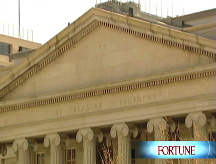House Dems offer $825B stimulus bill
Package includes $550 billion in spending and state aid plus $275 billion in tax cuts. Pelosi: 'We wanted to get the biggest bang for the buck.'
NEW YORK (CNNMoney.com) -- After weeks of talks with President-elect Barack Obama's top aides, House Democrats on Thursday released an expansive economic recovery plan that calls for $550 billion in spending and aid to states and $275 billion in tax cuts.
House Speaker Nancy Pelosi, D-Calif., said lawmakers tried to assemble a package of measures that would be most effective in stimulating the U.S. economy, which is now in its 14th month of recession.
"We wanted to get the biggest bang for the buck," she said at a press conference.
Pelosi expressed confidence that Congress would reach the mid-February deadline for getting a bill to Obama's desk.
But, she noted, "this [package] is just the first step."
The $825 billion bill will now be directed to House committees for review and possible changes and later will be sent to conference with the Senate to resolve any differences the chambers may have.
Obama is scheduled to promote the bill on Friday in Ohio, where he'll speak with workers at a wind turbine factory. The package calls for more than $50 billion to double production of alternative energy.
"This plan is a significant downpayment on our most urgent challenges," Obama said in a statement. "[I]t will contain the kind of strict, independent oversight that will allow the American people to hold Washington accountable for how and where their tax dollars are spent."
The House proposal -- the American Recovery and Reinvestment bill -- is likely the most expensive spending plan Congress has ever proposed. Obama, who takes office on Tuesday, has called it central to stemming what has become the worst economic crisis in decades.
Obama's top economic advisers have estimated that the stimulus plan they laid out, which is largely reflected in the House Democrats' bill, could create or save between 3 million and 4 million jobs by 2010 across a broad array of industries.
But members of Obama's team and other economists acknowledge that even that level of job creation wouldn't be a panacea for the economy. Rather, it would lead to a lesser rate of unemployment than would otherwise be the case if there was no economic recovery package.
The bill includes roughly $90 billion to modernize roads, bridges, mass transit and waterways, and over $140 billion, mostly to states and localities, to defray their costs for education and to modernize schools.
The bill also calls for a number of measures to help the economically vulnerable. Among them: $27 billion to continue the current extended unemployment benefits program through Dec. 31; and another $9 billion to increase the average unemployment check by $25 a week on top of the roughly $300 a week jobless workers currently receive.
There is also a provision calling for $30.3 billion to subsidize for 12 months the cost of Cobra health insurance coverage and extend the time eligible workers may keep it. Cobra coverage allows newly laid off workers to keep health insurance provided by their former employers. Workers who would be eligible are those 55 and older and those who have at least 10 years' tenure with their employer.
The bill put together by House Democrats doesn't include everything Obama wanted.
After complaints from Democrats in both chambers, negotiators dropped a $3,000-per-hire tax credit that Obama proposed to provide incentives for employers to create jobs in the United States. Critics said the measure wouldn't achieve its aim since it wasn't large enough to help employers who can't afford a worker's total compensation in the first place.
But another tax cut -- one aimed at broadening businesses' ability to write off their losses, called "net operating loss carryback" -- is still in the package, although it's unclear if it will remain in the final bill.
Although no specifics were offered in the House's summary of provisions, the package also includes a "Making Work Pay Credit," which is something that Obama campaigned on.
The credit as Obama described it would provide low- and middle-income workers with a tax cut equal to $500 a year for individuals and $1,000 for couples. The money could be delivered fairly quickly to workers, with companies reducing the tax they withhold from employees' paychecks. The credit would also be refundable, meaning eligible workers can get it even if they don't make enough money to owe income tax.
The bill also includes an expansion of the Earned Income Tax Credit, which is a refundable credit for low-income workers, and an increase in the child tax credit.
While many Republicans in the House and Senate are on board with having a stimulus package, they have been pushing for a different balance of measures, with a much stronger emphasis on tax cuts for businesses and individuals.
House Minority Leader John Boehner, R-Ohio, on Thursday characterized the Democrats' plan as "disappointing."
"The plan ... was developed with no Republican input and appears to be grounded in the flawed notion that we can simply borrow and spend our way back to prosperity," Boehner said in a statement. "It calls for more than half a trillion dollars in questionable new government spending on programs and projects, while providing less tax relief for middle-class families and small businesses than President-elect Obama has proposed."
Alternative stimulus bill proposals were put forth by the Republican Study Committee on Wednesday. The proposals called for far more business tax cuts, such reducing the corporate income tax rate.
Obama has said he's willing to consider any ideas for stimulus that have proven to work in the past, no matter which party proposes them. The problem is there is more ideological passion about whether tax cuts or government spending works best to create jobs than there is definitive research to settle the question.
But both government spending and tax cuts can prove very expensive in the long run if they aren't successful.
A big concern for all lawmakers has been how the government will oversee the monies given to states or spent on federal projects.
The House Democrats' bill calls for several measures to ensure transparency and accountability.
Among them, the creation of a special Web site where lawmakers and the public can track how funds are spent, get contact information for the managers of programs receiving funding and a list of contract or grant recipients. Plus, there would be links to the contracts themselves.
The bill would also require state or local government agencies that receive grant money for operations to post the intended use of the grant money as well as the numbers of jobs saved or created as a result.
The legislation also offers protection to federal and state whistleblowers and calls for those making the funding decisions (i.e., governors, mayors and others) to personally certify that a project has been vetted and that the money spent is an appropriate use of taxpayer dollars.
Lastly, the bill calls for the creation of two boards:
- A Recovery Act Accountability Board, members of which will include the president's chief performance officer and others appointed by the heads of federal agencies.
- An independent advisory panel to that board, members of which will not be in the federal government but will have expertise in economics, public finance, contracting, accounting, auditing or other relevant fields.
- CNN congressional producer Deirdre Walsh contributed to this report. ![]()



